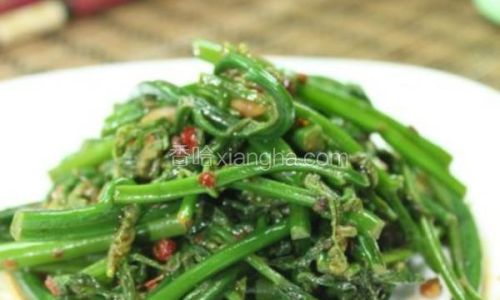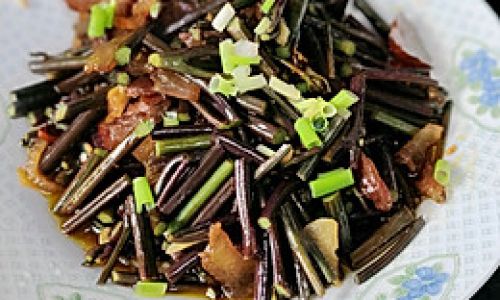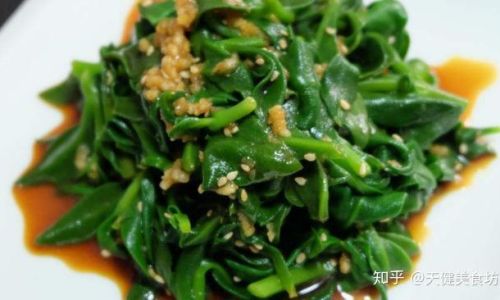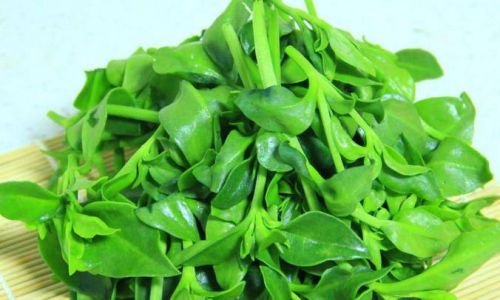Table of content
Wild water fern, known scientifically as Marsilea quadrifolia, is a lesser-known yet deeply revered green in certain regional cuisines, particularly in parts of Asia. Often dubbed a “hidden gem” of the vegetable world, this aquatic plant thrives in freshwater marshes, streams, and ponds, boasting a delicate, feathery texture and a mild, earthy flavor. When transformed into a stir-fry, it becomes a vibrant dish that balances umami-rich seasonings with the fern’s natural crispness. This article delves into the intricacies of preparing Stir-Fried Wild Water Fern—a dish that marries simplicity with culinary finesse, ensuring every bite is a celebration of texture and taste.

Understanding Wild Water Fern: A Brief Introduction
Before diving into the recipe, it’s essential to appreciate the ingredient itself. Wild water fern is not a true fern but a member of the Marsileaceae family, characterized by its four-leaflet clusters, which resemble small clover leaves. The plant’s stems are tender and crunchy, with a flavor profile that hints at spinach and asparagus, making it a versatile addition to stir-fries, soups, or salads.
In traditional Chinese cuisine, wild water fern is prized for its perceived health benefits, including detoxifying properties and its ability to aid digestion. Its seasonal availability—typically spring to early summer—adds an element of exclusivity, encouraging cooks to savor it while it lasts.
Key Ingredients for Stir-Fried Wild Water Fern
To recreate this dish authentically, gather the following ingredients. Quantities are tailored to serve four people as a side dish or light main course:
- 500 grams fresh wild water fern: Look for vibrant green stems with firm, unbruised leaves. Avoid wilted or yellowing specimens.
- 3 tablespoons cooking oil: Neutral oils like peanut, vegetable, or canola work best to avoid overpowering the fern’s delicate taste.
- 3 garlic cloves, minced: For aromatic depth.
- 1-inch ginger, julienned: Adds a subtle warmth.
- 2-3 dried red chilies (optional): For a mild heat; adjust to taste.
- 1 tablespoon Shaoxing wine: Enhances umami; substitute with dry sherry if unavailable.
- 1 tablespoon oyster sauce: Provides a savory backbone.
- 1 teaspoon light soy sauce: Balances saltiness.
- 1/2 teaspoon sugar: To mellow the flavors.
- 1/4 teaspoon white pepper: For a hint of spice.
- 1 tablespoon cornstarch mixed with 2 tablespoons water: For thickening the sauce (optional).
- Salt to taste: Adjust according to preference.
Preparation: Cleaning and Trimming the Fern
Wild water fern requires meticulous cleaning due to its aquatic habitat. Follow these steps:
- Rinse Thoroughly: Submerge the fern in a large bowl of cold water, swishing gently to dislodge any mud or debris. Repeat until the water runs clear.
- Trim the Stems: Using a sharp knife, slice off the tough lower 1-2 inches of each stem. The remaining stems should be tender and crisp.
- Separate Leaves and Stems: While optional, some chefs prefer to halve the stems lengthwise for faster cooking. Leave the leaves intact for visual appeal.
- Blanching (Optional): For a brighter green color and slightly softer texture, blanch the fern in boiling water for 30 seconds, then shock in ice water. Drain thoroughly.
Cooking Technique: The Stir-Fry Process
Stir-frying is a high-heat, quick-cooking method that preserves the fern’s texture and vibrancy. Follow these steps for flawless execution:
Preheat the Wok
Place a wok or large skillet over high heat. Allow it to smoke lightly—a hallmark of proper wok hei (the breath of the wok). Add the oil and swirl to coat the surface.
Aromatics First
Reduce the heat to medium, then toss in the garlic, ginger, and dried chilies. Stir-fry for 20-30 seconds until fragrant but not browned. Overcooking aromatics can impart bitterness.

Introduce the Fern
Turn the heat back to high and add the wild water fern. Use tongs or a spatula to toss continuously, ensuring even cooking. The fern will wilt slightly but retain its crunch—a sign of proper doneness.
Deglaze with Shaoxing Wine
Pour the Shaoxing wine around the edges of the wok. The alcohol will evaporate quickly, leaving behind a subtle sweetness. Scrape any browned bits from the wok’s surface to incorporate into the dish.
Season and Toss
Add the oyster sauce, soy sauce, sugar, and white pepper. Toss vigorously to coat the fern evenly. Taste and adjust seasoning with salt if needed.
Thicken the Sauce (Optional)
For a glossy finish, drizzle the cornstarch slurry into the wok while stirring. Cook for an additional 30 seconds until the sauce clings lightly to the fern.
Serve Immediately
Transfer the stir-fry to a platter. Garnish with toasted sesame seeds or thinly sliced scallions for a pop of color.
Expert Tips for Perfect Stir-Fried Wild Water Fern
- Timing is Key: Overcooking the fern will render it mushy. Aim for 2-3 minutes of total cooking time.
- Wok Maintenance: A well-seasoned wok prevents sticking and enhances flavor. Avoid using nonstick pans, as they cannot withstand high heat.
- Flavor Variations:
- Spicy: Add fresh bird’s-eye chilies or a dash of chili oil.
- Umami-Rich: Incorporate dried shrimp or fermented black beans.
- Vegetarian: Substitute oyster sauce with mushroom-based stir-fry sauce.
- Storage: Leftovers can be refrigerated for up to two days, though the texture softens. Reheat gently in a pan with a splash of water.
Health Benefits of Wild Water Fern
Beyond its culinary appeal, wild water fern is a nutritional powerhouse:
- Rich in Vitamins: High in vitamin A, C, and folate, which support immune function and cellular health.
- Mineral Dense: Contains iron, calcium, and potassium, essential for bone health and circulation.
- Low in Calories: A 100-gram serving provides under 20 calories, making it ideal for weight-conscious diets.
- Antioxidant Properties: Compounds like flavonoids combat oxidative stress, potentially reducing inflammation.
Cultural Significance and Regional Adaptations
In regions where wild water fern grows abundantly, such as parts of China, Japan, and Southeast Asia, the vegetable holds cultural significance. During spring festivals, it often graces tables as a symbol of renewal and prosperity.

Regional Twists:
- Japanese Adaptation: Known as yomogi, it’s sometimes blanched and served with sesame dressing.
- Thai Influence: Paired with coconut milk and lemongrass for a creamy curry.
- Vietnamese Style: Stir-fried with shrimp paste and crushed peanuts.
Troubleshooting Common Issues
- Soggy Texture: Overcrowding the wok traps steam, leading to mushiness. Cook in batches if necessary.
- Bland Flavor: Ensure aromatics are properly sautéed to release their oils.
- Bitter Aftertaste: Avoid burning garlic or ginger; remove the wok from heat if smoking excessively.
Pairing Suggestions
Stir-fried wild water fern pairs beautifully with:
- Steamed Jasmine Rice: Balances the dish’s assertive flavors.
- Grilled Proteins: Chicken, tofu, or shrimp complement its earthiness.
- Light Soups: A clear broth with mushrooms or tofu creates a harmonious meal.
Conclusion: A Dish Worth Savoring
Stir-fried wild water fern is a testament to the magic of simplicity. With minimal ingredients and precise technique, it transforms a humble aquatic plant into a dish that dazzles the palate. Whether you’re a seasoned cook or a curious novice, mastering this recipe offers a gateway to exploring lesser-known vegetables and honing your stir-fry skills. So, the next time you spot wild water fern at a market, seize the opportunity—and your wok—to create a meal that’s as nourishing as it is unforgettable.
Final Tip: Experimentation is encouraged! Adjust the seasonings to suit your taste, and don’t shy away from adding unexpected ingredients like citrus zest or toasted nuts for a personalized twist. After all, the best recipes are those that tell your story.






0 comments